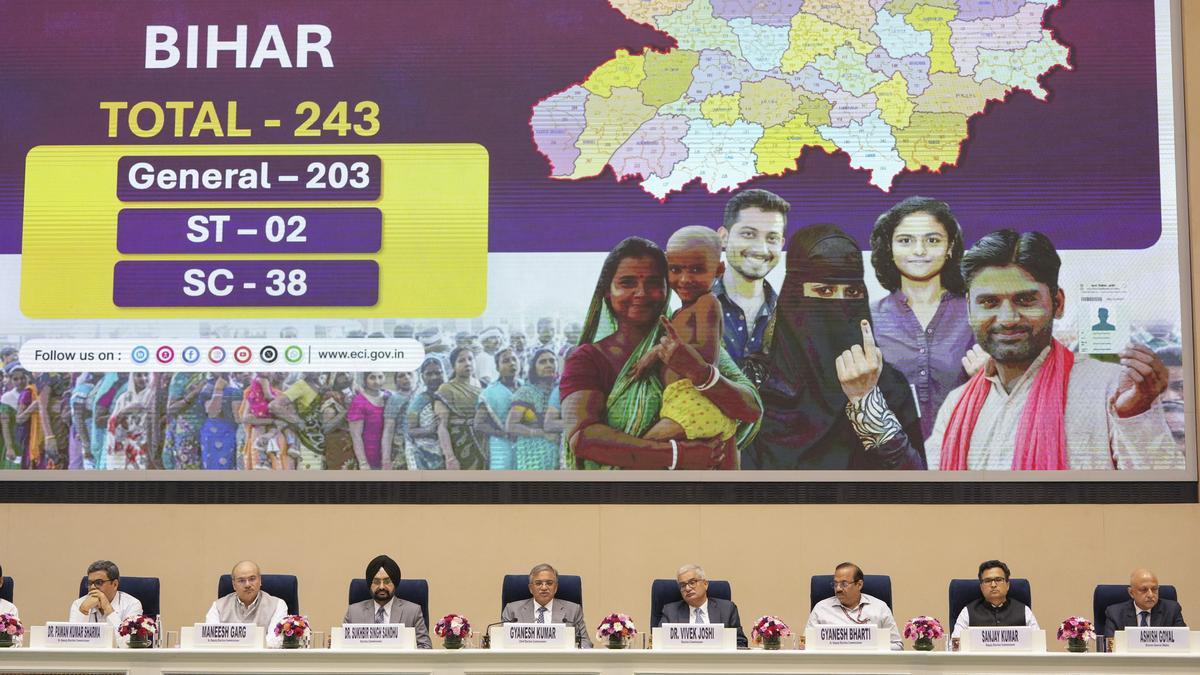The Assembly election in Bihar — being held in two phases, November 6 and 11, with results to be declared on November 14 — is a high-stakes battle for all players.
An in-depth look at the state of play in the State shows that each big party is grappling with its own issues, both internally and externally. The caste arithmetic has remained more or less static in the State over the past two decades, ever since the ascendancy of Chief Minister Nitish Kumar.
Upper castes are largely said to be with the BJP, and non-Yadav Other Backward Classes, Extremely Backward Classes (EBCs), and Mahadalits, along with Pasmanda, or lower caste Muslims, with the Mr. Kumar-led Janata Dal (United). They largely form the nucleus of the ruling National Democratic Alliance (NDA).
The larger group of Muslims and the numerically strong Yadav community are consolidated behind the Rashtriya Janata Dal (RJD), with the Congress and the Communist Party of India (Marxist-Leninist) Liberation having their own limited pockets of influence. They make up the Mahagatbandhan, or the grand alliance, the version of the Indian National Developmental, Inclusive Alliance (INDIA) in the State.
Bihar election LIVE: NDA seals seat-sharing formula
In the middle are smaller parties such as the Lok Janshakti Party (Ram Vilas), the Hindustan Awam Morcha, and the Rashtriya Lok Manch, which are with the NDA, and other smaller caste-based parties such as the Vikassheel Insaan Party, which are currently in negotiations for seats with the grand alliance.
The Nitish factor
In this scenario, Mr. Kumar has been a constant, flitting between the two alliances, due to the nature of his support base, and remaining Chief Minister whichever alliance is in power.
The biggest issue looming over the NDA, for instance, is Mr. Kumar’s health and prospects of his continuing as Chief Minister for a full term if the alliance wins. For the JD(U), it puts a question mark on its leadership and speculation over succession.
For the BJP, with the death of its tallest leader in the State, Sushil Kumar Modi, there is a very visible lack of State-level leadership affecting its organisation. Prime Minister Narendra Modi is an important face, but the fact that Deputy Chief Minister Samrat Choudhary came from the RJD and other leaders do not carry the heft of Sushil Modi is telling on organisational cohesion. The NDA, as the ruling alliance, therefore, is leaning on the women’s vote.

Programmes and income support schemes such as the Mukhyamantri Mahila Rozgar Yojana, disbursing ₹10,000 each to women beneficiaries of the entrepreneurial scheme, apart from pay hikes for local welfare workers and reservations in government jobs are part of an attempt by the NDA to create a “casteless” category of beneficiary, or ‘labarthi’, voters among women.
Spectre of jungle raj
While the NDA is grappling with its internal issues and a nearly 20-year stay at the helm with its attendant anti-incumbency factor, the RJD has two fundamental problems. The memories of “jungle raj”, or the intense governance deficit faced by the State under its rule, remain fresh, bolstered by the NDA’s campaign to remind voters about it. Second, the party’s Muslim-Yadav support base has not, in the past two decades, been enough to push it over the half-way mark.
RJD leader Tejashwi Yadav’s promise of a government job for every household is a way of ameliorating that deficit as economic justice within the social justice matrix. A failure by the RJD to attain power in a fifth election in a row on its own will raise serious issues with regard to its survival.
The Congress, declining since the late 1980s, overshot its mark in the 2020 polls by fighting 70 seats and winning only 19.
This time, it is attempting a revival, with a 10-point programme aimed at the EBCs, including additional reservations and a law similar to the SC/ST Prevention of Atrocities Act.
In this status quo, the new disruptor, Jan Suraaj Party (JSP), and its leader, poll strategist-turned-politician Prashant Kishor, may become an “X” factor. Having toured the State for three years and launching his party thereafter, Mr. Kishor says he will take the State to “Development 2.0”, from the governance blackhole of the 1990s to Mr. Kumar’s maternal welfare State of the past two decades, to a concerted effort to stem migration and generate jobs.
Both alliances are wary of the JSP, a question mark hanging over whose votes the new party will cut into.
Bihar’s polity has always privileged questions of social justice, with Mr. Kumar reinterpreting Mandal politics into gender justice and that of the EBCs within the larger OBC umbrella.
Published – October 12, 2025 08:21 pm IST
